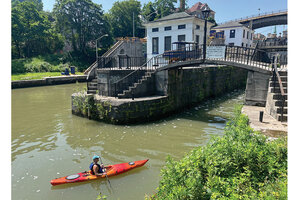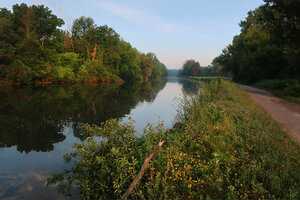Biking the Erie Canal, I pedaled through history

A kayaker waits his turn at locks 34 and 35 in Lockport, New York. The newer steel locks sit next to the 1825 Flight of Five, a five-lock stair that lifted boats 60 feet in a stretch of 450 feet.
Alfredo Sosa/Staff
Along the Erie Canal, N.Y.
When I set out to ride my bicycle from Ontario to my home in Rhode Island, I knew very little about the Erie Canal.
I didn’t know that it was considered an engineering feat when it was completed in 1825, or that it changed the economy of the region by allowing faster transportation of goods from Buffalo to New York City. And I surely did not know how the canal transformed towns along its 339 miles, not unlike the Interstate Highway System more than a century later.
What I do know is that I love to travel by bike. I love the pace that cycling allows. In a way, it’s not too different from the pace of the motorized boats that replaced the original barges, which were towed by mules. A guide at the Old Erie Canal Heritage Park in Port Byron, New York, told me that the canal cut the travel time across the state from three weeks to a single week.
Why We Wrote This
What do our usual modes of transportation keep us from seeing? Riding his bike from Ontario to Rhode Island, the Monitor’s director of photography caught unexpected glimpses of an oft-forgotten past.
As I rode along the canal’s towpaths, stopping to watch the locks in action, visit historic sites, and talk to people, I was transported to a time when this thoroughfare facilitated economic and – just as important – cultural and social interactions.
The photos in this essay were taken from my bike on the Erie Canalway Trail and are a small portion of the visual treats I found along the way.


